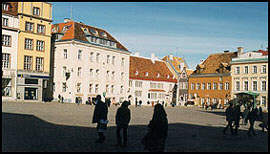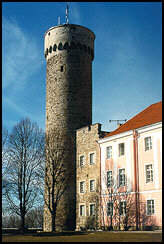 Facts about Estonia Facts about Estonia |

 Temperature Temperature |
Estonia has a moderately cool and moist temperate climate characterized by rather warm summers and rather mild springs and autumns. Winter lasts from November to mid-March and can be very cold. The weather is often breezy and highly changeable due to the proximity of the Baltic Sea. Average temperature ranges from 21oC (70oF) in summer (usually in July) to -8oC (17,6oF) in winter (usually in February). Severe frosts of thirty or more degrees below zero (-16oF) or scorchers of thirty or more degrees above zero (80oF) are rare.
The snow cover stays usually from the beginning of December until the end of March but in exceptionally mild winters, there is almost no snow at all.
There are normally about 150-200 rainy days a year. Total precipitation is 600 mm/yr and average humidity 81%.
Coastal waters warm up to 21oC (70oF) in summer.
An umbrella and a light overcoat are good choices even for summer visitors. In autumn, winter and spring a topcoat is a must. The clothes you pack for your trip to Estonia should be flexible enough to allow for temperature change.
The best time to visit Estonia is from May to September. Around midsummer the sun does not set until after 11.00 and even then it does not get completely dark; a silvery twilight remains in the sky throughout the night.
Average temperature and precipitation in Tallinn: |
 Nature Nature |
Estonia's forests contain elk, deer, wild boar, badger, fox, squirrel and beaver. The brown bear, wolf and lynx are much rarer, but still seen. The national bird is the barn swallow. Other birds you'll find in Estonia are the house sparrow, blackbird, white stork, woodcock, golden eagle, but migrating birds as geese, swans and ducks feel in Estonia at home, too.

The most common tree is the pine, followed by the birch, spruce, aspen, oak and alder. The national flower is the cornflower.
Estonia nature is a seeming paradox; many believe it to be a severely polluted, however, it is better preserved than that in most Western nations. While the storks have disappeared, they are still common in Estonia, where the bogs and natural wetlands remain untouched.
 Time Time |
Time in Estonia is two hours ahead of Greenwich Mean Time in winter and three hours ahead during the summer months (Daylight Saving Time is in effect from March until October). [not any more this year! - Angelika added]
It is 3 pm in Tallinn when it is 2 pm in Stockholm
or 1 mp in London, but it would be more correct
to say that it is 15.00 in Tallinn as Estonia runs
on the 24-hour timetable. |

